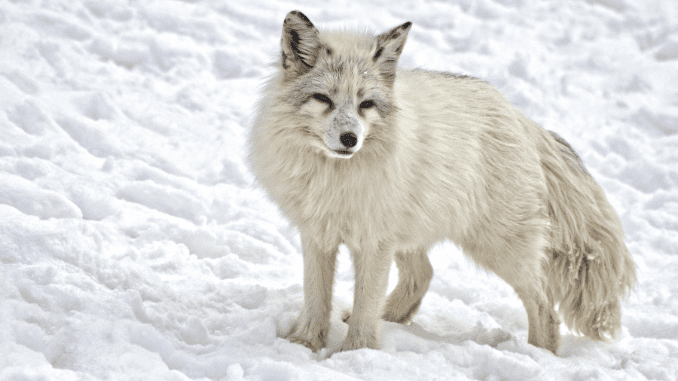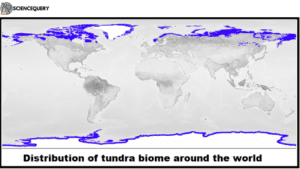
Introduction
The flow of energy in an ecosystem through various plants and organisms is known as the food chain. The tundra biome has a unique food chain that helps sustain the tundra ecosystem to its full potential.
Tundra Biome
The word ‘biome’ is defined as a large, distinct ecological area on the surface of the earth characterized by specific climate, soil, and vegetation that influences the types of animals that inhabit the region. The word ‘tundra’ originates from the Finnish ‘tunturia’, meaning ‘barren land’. Another meaning from the Kildin Sami term ‘tundar’ is ‘treeless mountain track’.The tundra ecosystem is very low in biodiversity. There are only about 1700 varieties of plants and about 48 varieties of land mammals found in the tundra region.
Characteristics
The characteristic features of the tundra biome are-
- Fully frozen, too dry, and cold regions.
- A kind of barren land with an ice desert.
- High altitude and top of mountains.
- Short summer, long winter.
- Unique animal adaptations- large compact bodies covered with furs and feathers.
- Ground-hugging plant forms.
Types
Based on their geographical setting tundra biomes are divided into two types-
1. Arctic tundra

Location
Northern Alaska, Canada, Greenland, Northern Asia, Siberia.
Temperature
Average temperature is -34ºC, average summer temperature is 3-12 ºC, and annual precipitation is 15-25cm.
Flora
- Low shrubs, sedges, mosses, liverworts, and grasses.
- 400 varieties of flowers.
- Crustose and foliose lichen.
Fauna
- Herbivorous mammals- lemmings, voles, arctic hares and squirrels
- Carnivorous mammals- arctic foxes, wolves, and polar bears.
- Migratory birds- ravens, snow buntings, falcons, loons, terns.
- Insects- mosquitoes, flies, moths, blackflies, arctic bumble bees.
- Fish- cod, flatfish, salmon, trout.
2. Alpine tundra

Location
- North America- Alaska, Canada, USA, Mexico
- Northern Europe- Finland, Norway, Russia, Sweden.
- Asia- Himalayan mountains, Japan.
- Africa- Mt. Kilimanjaro
- South America- Andes mountains.
Temperature
The alpine tundra biome is also called a cold climatic region with temperatures averaging below freezing point at nights. The average rainfall is around 45cm, that too in the form of snow. Strong winds blow at speeds exceeding 200kmph.
Flora
- Tussock grasses, dwarf trees, small-leafed shrubs, and heaths.
Fauna
- Mammals- pikas, marmots, mountain goats, sheep, elk.
- Birds- grouse-like birds.
- Insects- springtails, beetles, grasshoppers, butterflies (1).
Primary producers of Tundra
- A lichen is a plant made up of fungus and green algae.
- They are the primary producers in the tundra biome food chain.
- They grow almost everywhere.
- Mosses and dwarf shrubs convert sunlight into energy through the process of photosynthesis.
Herbivorous of Tundra
- Lemmings are small mice-like animals.
- They have sharp claws which help them to dig holes.
- Caribou and reindeer feed on plants, the primary producers of the tundra biome food chain.
Carnivorous of Tundra
- Arctic foxes, wolves, and polar bears are among the carnivorous animals in the tundra biome.
- They feed on herbivores, acting as secondary consumers.
Decomposers of Tundra
- Bacteria and fungi are the decomposers in tundra biomes.
- They break down the organic matter in the tundra and recycle the nutrients back into the soil (2).
Tundra food chain

- The tundra food chain begins with the energy captured from the sun by mosses, and lichens who are the primary producers in the form of photosynthesis.
- The next organism in the tundra food chain is the arctic rabbit.
- A rabbit is a herbivore and gets its energy from eating arctic plants like mosses etc.
- The rabbit gets eaten by the snowy owl, who is a consumer and a carnivore.
- Next, the arctic owl gets eaten by the arctic fox. Arctic foxes are both carnivorous and omnivorous.
- The arctic fox gets eaten by the arctic polar bear as it is a carnivore, and the energy gets transferred.
- The waste of the arctic bear gives energy to the decomposers who are also called detritivores.
- There are three types of decomposers in the arctic food chain. They are fungi, bacteria, and lichens.
- The cycle is continuous and very interesting (3).
Challenges and Adaptations
The tundra biome and food chain is a unique ecosystem on its own, but it faces some challenges such as
- The tundra biome experiences very low temperatures which is challenging for both the arctic animals and plants.
- The growing season in the tundra biome is short and brief due to coldness which limits the growth of plants.
- The harsh conditions make it challenging for a variety of species to survive resulting in low biodiversity.
- Permanently frozen soil restricts root growth.
Along with the challenges, there are a few adaptations
- Camouflage- animals in the Arctic have white fur, and feathers which help them to blend with the snowy surrounding against predators.
- Insulation- arctic foxes, and polar bears have thick fur and layers of fur to insulate them against the cold.
- Migration- animals and certain bird species in the Arctic go for seasonal migration to find food and mates.
- Low-lying plants- plants like mosses, lichens, and shrubs stay close to the ground to minimize exposure to cold and wind (4).
Q&A
1. What is a food chain in a biome?
A food chain in any biome mentions who eats whom in the wild. It starts with producers and ends with decomposers. It helps to maintain the flow of energy in an ecosystem.
2. What are the trophic levels of the tundra food chain?
The levels in the tundra biome food chain are divided into
- Producers- lichens, mosses.
- Primary consumers- herbivores like arctic rabbits.
- Secondary consumers- carnivores like arctic foxes.
- tertiary/apex consumers- omnivores like Arctic polar bears.
- Decomposers- fungus, bacteria.
3. What is the food chain of the Siberian tundra?
The Siberian food chain is divided into
- In Siberian tundra, the producers are lichens, grasses, and arctic wildflowers.
- The herbivores are arctic hare, lemming, and musk.
- The carnivores include hawks, polar bears, and wolves.
- This food web is missing the main component in the transfer of energy.
4. What are the decomposers in the tundra biome food chain?
The decomposers in the tundra biome are molds, yeasts, fungi from lichen, and bacteria.
5. What is a biome in simple definition?
Biomes are very large ecological areas on the earth’s surface, with fauna and flora adapting to their environment.
6. What is a biome explained for kids?
Biomes are regions of the world with similar climates, animals, and plants.
7. What is the difference between biome and ecosystem?
The few major differences between biome and ecosystem are-
Biome |
Ecosystem |
|
|
|
|
|
|
8. What are the 7 major types of biomes?
The seven major types of biomes present in the world are-
- Equatorial and tropical rainforest.
- Tropical savanna.
- Temperate rainforest.
- Mid-latitude grasslands.
- Warm and cold desert.
- Arctic tundra.
- Alpine tundra.
Summary
- The tundra biome is characterized by extremely cold temperatures, permafrost, and a short growing season.
- It is found in arctic and subarctic regions.
- It has a very unique food chain, which means the transfer of energy through various elements of the ecosystem.
- The arctic food chain starts with producers like lichens and gets the energy transferred through primary, secondary, and tertiary consumers like rabbits, foxes, and arctic bears respectively.
- Despite low biodiversity, the tundra shows remarkable adaptations like insulation, camouflage, etc.
- Threats from humans like oil extraction, emphasize its conservation needs.
References
1. D. S. Lal. Physical Geography. Sharda Pustak Bhavan, Allahabad. Chapter 56- Biome, Page no- 774-780.
2. Rajiv Ahir. Spectrums Geography.Spectrum Books Pvt.Ltd, New Delhi. Chapter 201-Major biotic regions of the world. Page no: 242-251
Written By: Ankita Gangopadhaya
